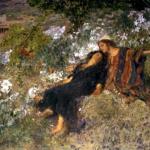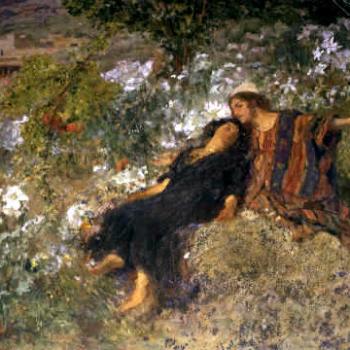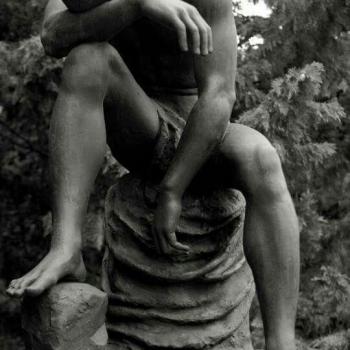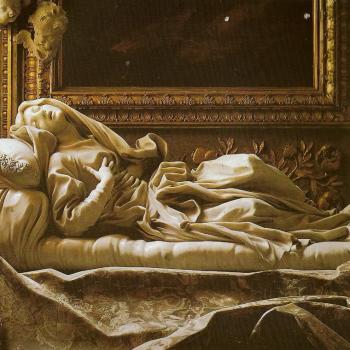The intended meaning of the Song of Songs has been a matter of contention since well before the second century after Christ, when it was first accepted into the Jewish canon of scripture. The poem’s focal point, a blatantly erotic relationship between two lovers, has presented readers with a quandary: what is an erotic love poem doing in the scriptures? The curious placement of this book has been interpreted in a variety of ways, ranging from an explicitly literalist reading, to a purely allegorical reading, and readings that combine both approaches.
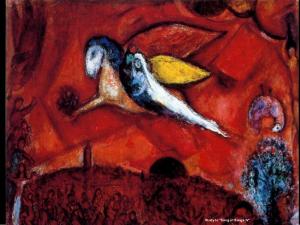
Christian exegetes followed the example of their Jewish predecessors by opting for an allegorical reading of the Song. The metaphor of God’s love for Israel was appropriated for a Christian audience by assigning the figure of the bride to the Church and the bridegroom to Christ. This allegory spoke descriptively of the nature of God’s relationship with humanity, but also alluded to specific events in history past and to come (the Incarnation, the Crucifixion, the Second Coming, etc).
Literalist readings were largely rejected due to the presence of “absurdities” in the text. Following in Origen’s tradition, the Song was placed in the context of the “spiritual structure” that continues through Scripture in its entirety. The spiritual meaning is made apparent through the literal sense of most books. Other books, however, contain absurdities or anomalies that render the literal sense of the book nonsensical.
The explicitly sexual themes found in the Song were considered too anomalous to be read literally. The spiritual meaning, then, is pointed to by, but not contained within, the apparent literal meaning of the text.
Patristic and Medieval writers relied on a neoplatonic understanding of Forms (“formalism”) to make sense of the allegorical relationship between eros and divine love. Denis Turner distinguishes between the notions of ontological participation and epistemological mimesis to express the method by which medieval monks sorted out the allegory. He refers to Pseudo-Denys whose neoplatonic theology relates the material to the immaterial by means of a “sliding scale” of likeness and unlikeness; he divides this scale into two categories: similar similarities and dissimilar similitudes. Some material realities are similar to their immaterial, or their ideal, form, insofar as that share a similar image, and others insofar as they participate in likeness. The majority of medievals opted for a strictly allegorical reading of the Song, with little regard for its literal implications (its historical or narrative truth), because they understood human eros and conjugal union as sharing the same image as, and not participating in likeness of, divine love. “There is always something suspect about sexual love,” claimed Nicholas of Lyra. Erotic love is too earthly and bound to the flesh to participate in divine love. To further express this distinction, Turner uses the example of a map and the land itself which it charts. Human sexuality is an image of God’s love for humanity (the Church/the individual soul). The map itself does not participate ontologically in the likeness of the land, it only shares in its appearance (epistemological mimesis).
Turner also uses the example of a temperature of a room and a thermometer to clarify this distinction. In the same way that the temperature of a room effects, and thus is reflected by, a thermometer, God’s love for humanity brought human sexuality into existence and is reflected in it. The relationship is only formal, though. The reading of the thermometer in no way participates in or effects the temperature of the room. This opinion played a role in the Church’s theology of marriage as sacrament. Marriage was not universally recognized as a sacrament until the thirteenth century. According to Aquinas, a sacrament is a “sacred sign which effects what it signifies.” All of the sacraments both signified and contained effectively the “great mystery” of the union between Christ and the Church. While earlier theologians like Peter Lombard questioned the sacramentality of matrimony on the grounds that it does not confer grace, Aquinas affirmed that matrimony is indeed a sacrament as it is an efficacious sign of grace. He did doubt, however, the extent to which the conjugal act was essential to marriage and thus its capacity to effect grace. While the mystery of Christ’s union with the Church may be the thing signified (res significata) by carnal union, it cannot be said to effect (sed non contenta) or participate in that mystery.
Turner speculates that medievals dismissed the possibility of the conjugal union participating in divine love because they “[were] not interested in sexual love as such.” He continues, “the monk saw ample opportunity to exploit the eroticism of the Song from the standpoint of his monastic life, for, as ‘image’ of his personal vocation and asceticism, it mapped perfectly on to it…As marriage could be an image of Christ and the Church, so too it could be an image of his way of life; it it was his way of life, not marriage, which he saw as the true participation in the mystery which marriage images.”
While early Patristic and medieval Scholastic readings of the text looked toward the collective and thus ecclesiological implications of the allegory, medieval monastic readings looked toward its individual and spiritual implications. Turner cites Bernard of Clairvaux, Denys the Carthusian, and Nicholas of Lyra, among other medieval monks who took the Song to reflect the dynamic between the individual soul and God. The mystical individualist reading reached its height in John of the Cross’ Spiritual Canticle, a poem and prose text inspired by the Song. In the Canticle, “all is the individual soul and God, and personal and solitary dialogue with one another. Gone, even as a distinct alternative reading, is any ecclesiological interpretation of the received imagery; gone is that sense that all time in history is an outpouring of the Holy Spirit and ecstatic love of the human race, of Israel and of the Church; gone, therefore, is the careful dovetailing of moral interpretation with the great sweep of ecclesiological eschatology…it is collapsed into a truly individualized tropology, into, we could say, a personalized ‘mysticism’ in the modern sense.” The erotic imagery found in the Canticle is removed from the “metaphysical world of dionysian neoplatonism…[it] ‘lacks roots’…within a stabilising world-view.” John does not use erotic imagery as a mere metaphor for the soul’s relationship with God. He “does not just think of love as eros. He loves God erotically.” Human and divine eros are not clearly delineated, rather, they “overlap” and are “superimposed” upon each other. Turner points out this spiritualization of human erotic imagery in stanza 33 of the Canticle:
Do not despise me; /for if, before, you found me dark, /now truly you can look at me /since you have looked /and left in me grace and beauty.
…which alludes to Song 1:5-6:
Dark am I, yet lovely, daughters of Jerusalem, dark like the tents of Kedar, like the tent curtains of Solomon. Do not stare at me because I am dark, because I am darkened by the sun. My mother’s sons were angry with me and made me take care of the vineyards; my own vineyard I had to neglect.
John comments:
“the bride dares to tell her Beloved not to consider her any longer of little account and not to despise her. If she previously merited this treatment because of the ugliness of her faults and the lowliness of her nature, now, after he has looked at her the first time, by which he arrayed her in his grace and clothed her in his beauty, he can easily look at her the second time and many more times, making this grace and beauty grow.”
The mystical individual reading introduced a significant shift from both Jewish and Christian exegetical traditions and reopened the door to old debates regarding the relationship between the erotic and the divine.
The full version of this essay was originally published at Homiletic and Pastoral Review.
Click here to read part 2: Post-Medieval Readings of the Song of Songs


